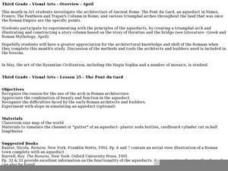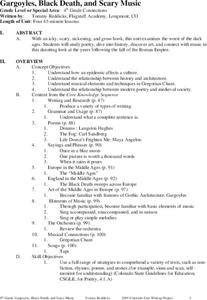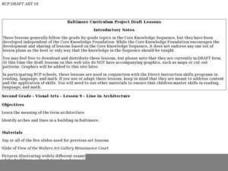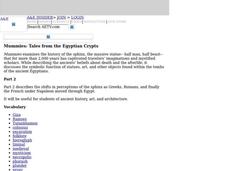Curated OER
Visual Arts - Overview - April
Third graders investigate the architecture of Ancient Rome, The Pont du Gard, an aqueduct in Nimes, France; The Pantheon and Trajan's Column in Rome; and various triumphal arches throughout the land that was once the Roman Empire are the...
Curated OER
Neo-Classicism
Taking students from the origins of Neoclassical art, architecture, sculpture, painting, and decorative arts to the "sunset" of the artistic movement, this slideshow provides ample infomation and examples of the art form. The slides...
Curated OER
Different Points of View
Considering an examination of point of view? Use visual arts to engage learners in of this element of art and literature. Class members select a portrait from the Renaissance Connection and, guided by a series of brainstorming...
Curated OER
The Art of the Byzantine Empire
Eighth graders describe, analyze, and evaluate the history of the Byzantine Empire and Russia from about 300 to 1000 A.D. They emphasis the preservation of Greek and Roman traditions. Students analyze the Byzantine art and architecture.
Curated OER
Gargoyles, Black Death, and Scary Music
Students research the Dark Ages using books, the Internet, and other media. In this Dark Ages lesson plan, students study poetry, music, art, and the architecture of the Dark Ages.
Curated OER
Gothic Period
Students write down information on their outline from the Gothic PPT presentation. Then, they sketch a chair from the Gothic time period by looking through in magazines to find a pictures of a piece of furniture or architectural detail...
Curated OER
Secrets of the Parthenon
Students take a closer look at the Parthenon. In this world monument lesson, students watch PBS video segments about the reconstruction of the Parthenon in Greece. Students research how the ancient Greeks built the structure and discuss...
Curated OER
Mythology and Ancient Civilizations
Third graders examine ancient world civilizations and the mythologies they created to explain natural phenomena, as well as the writers and poets who wrote about the mythologies.
Curated OER
Every Building Tells a Story
Examine images from past that depict buildings and towns from their own communities, and compare images with photographs taken at present locations, interview local architect and compare role of 19th Century architect to 21st Century...
Curated OER
Visual Arts - Lesson 9 - Line in Architecture
Second graders study the meaning of the term architecture and identify arches and lines in a building in Balimore.
Curated OER
Colossal Structures and Sculptures
Students discuss the connection between culture and art and why people create art. Students discuss Mt. Rushmore, The Sphinx, the goddess Athena, Roman columns, The Great Wall of China, The Buddha, and use tools and techniques to create ...
Curated OER
Civilizations Leadership
Students view a segment of Prosperity and Decline. They discuss what attributes made the empire strong. Students discuss what caused the fall of the Roman Empire. They write an essay describing the cause of the fall of the Roman Empire....
Curated OER
Bestiarity and Gargoyles
Students complete an art project. In this gargoyles lesson plan, students learn about gargoyles and other medieval architecture features and discuss their purposes. Students create their own monsters using an etching technique. This...
Curated OER
Lesson Plan for St. Catherine
Students analyze the art of St. Catherine and Gothic Art. In this art analysis lesson, students read the biography of St. Catherine and read about the carving of the statue. Students complete a related statue art activity and carve their...
Curated OER
Wonders Of The World
Learners explore wonders of the world. In this ancient civilizations lesson, students create criteria for naming ancient wonders of the world and then use the criteria to evaluate wonders of world since the original list. Learners create...
Curated OER
Primary Structural Forms: Post and Beam
Students examine the three primary structural forms of architecture. They view photos, take a walking tour of their community, conduct strength tests of post, beam, and arch construction, and analyze the test results.
Curated OER
Mummies: Tales from the Egyptian Crypts Part II
Students explore the shifts in perceptions of the sphinx as Greeks, Romans, and finally the French under Napoleon moved through Egypt.
Curated OER
Social Studies: Renaissance
Students explore Renaissance architecture. In this Renaissance lesson, students view a slideshow featuring architecture of the era and then discuss the math skills used to the build the structures. Student build their own replicas of...
Curated OER
Their Names Are Pricked
Students discuss areas of ambiguity in Julius Caesar and analyze the language as a tool to illustrate complex desires. In this Shakespeare lesson, students define subtext and use a neutral scene to act out subtext. Students create their...
Curated OER
Introduction to the Byzantine Empire
Students research the founding of the Byzantine Empire in this lesson. They examine the geographic advantages of Constantinople, and the establishment of the empire. Finally, they compare the Byzantines, Romans, and present-day...
Curated OER
Personalities of the Renaissance
Have the class interpret historical evidence presented in primary and secondary resources. They examine sources regarding architecture, art, exploration, government, literature, religion, and technology of the era. Then they use their...
Curated OER
European Tour: History and Tradition: Sistine Chapel
Students explore the Sistine Chapel. In this visual arts lesson, students take a virtual tour of the Sistine Chapel. Students examine the scenes depicted on the chapel's ceiling and share their impressions of the artistic stories.
Curated OER
"Ancora Imparo" (Still I Am Learning)
Students study the Italian Renaissance, its impact, and origin. In this Italian Renaissance lesson, students study the Renaissance via the ancient civilizations and political geography of various countries. Students study the art prior...
Curated OER
Who Built the Pyramids?
Students examine the two theories on how the pyramids at Giza were built. They watch a video on pyramids, take notes, and write a five-paragraph essay on how they think the pyramids were constructed.

























